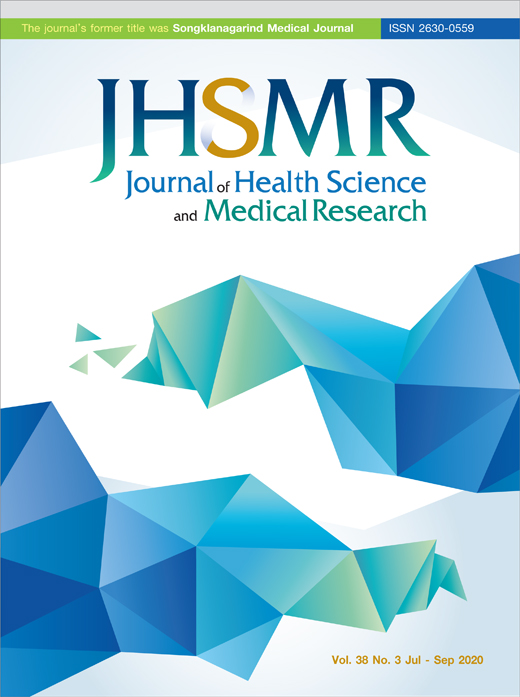Factors Associated with Occupational Hearing Loss among StoneMortar Workers in Phayao Province, Northern Thailand
DOI:
https://doi.org/10.31584/jhsmr.2020740Keywords:
occupational hearing loss, stone-mortar workersAbstract
Objective: Noise pollution is an unwanted phenomenon that affects human health and can lead to occupational hearing loss in exposed workers. The stone mortar industry is one of the processes which can create a noise hazard. This study aimed to explore the factors associated with occupational hearing loss among stone-mortar workers in Phayao Province, Northern Thailand.
Material and Methods: A cross-sectional study was conducted 27 stone-mortar workers who were interviewed with a questionnaire. Pure-tone hearing thresholds were measured using audiometry. The data were analyzed using Mann-Whitney U test, Spearman’s rank correlation test and Kruskal-Wallis test and Multiple linear regression analysis.
Results: The study found a significant difference between age and high frequency hearing loss in both right and left ears (p-values 0.024 and 0.049, respectively). There were significant correlations between working hours per day and high frequency hearing loss in both right and left ears (p-values 0.030 and 0.042, respectively). Multiple linear regression analysis found increasing age was associated with high frequency hearing loss in both right and left ears (p-values 0.033 and 0.017, respectively) after adjusting for number of years worked, working hours per day, and use of personal protective equipment as random variables.
Conclusion: All stone-mortar factories produce noise pollution. Therefore, the local policy makers should emphasize reducing noise pollution from stone factories and surveillance of occupational hearing loss to improve the quality of life of the people who work in such factories.
References
2. Pelegrin AC, Canuet L, Rodriguez AA, Morales MP. Predictive factors of occupational noise-induced hearing loss in Spanish workers: a prospective study. Noise Health 2015;17:343-9.
3. Hammersen F, Niemann H, Hoebel J. Environmental noise annoyance and mental health in adults: findings from the cross-sectional German Health Update (GEDA) study 2012. Int J Environ Res Public Health 2016;13:E954.
4. Hahad O, Kröller-Schön S, Daiber A, Münzel T. The cardiovascular effects of noise. Dtsch Arztebl Int 2019;116:245-50.
5. Li X, Dong Q, Wang B, Song H, Wang S, Zhu B. The influence of occupational noise exposure on cardiovascular and hearing conditions among industrial workers. Sci Rep 2019;9:11524.
6. Abbasi M, Monazzam MR, Akbarzadeh A, Zakerian SA, Ebrahimi MH. Impact of wind turbine sound on general health, sleep disturbance and annoyance of workers: a pilot study in Manjil wind farm, Iran. J Environ Health Sci Eng 2015;13:71.
7. Nelson DI, Nelson RY, Concha-Barrientos M, Fingerhut M. The global burden of occupational noise-induced hearing loss. Am J Ind Med 2005;48:446-58.
Fuente A, Hickson L. Noise-induced hearing loss in Asia. Int J Audiol 2011;50(Suppl 1):S3-10.
8. Kitcher ED, Ocansey G, Tumpi DA. Early occupational hearing loss of workers in a stone crushing industry: our experience in a developing country. Noise & Health 2012;14:68-71.
9. de Paiva Vianna KM, Alves Cardoso MR, Rodrigues RM. Noise pollution and annoyance: an urban soundscapes study. Noise & Health 2015;17:125-33.
10. Ryan AF, Kujawa SG, Hammill T, Le Prell C, Kil J. Temporary and permanent noise-induced threshold shifts: a review of basic and clinical observations. Otol Neurotol 2016;37:e271-5.
11. National Institute for Occupational Safety and Health (NIOSH). Occupational noise exposure [homepage on the Internet]. Georgia: NIOSH; 2014 [cited 2019 Dec 1]. Available from: https://www.cdc.gov/niosh/docs/98-126/default.html
12. Wongsuwan K, Rattanaarun K, Kittiwannawong K. Prevalence of noise-induced hearing loss in workers with noise exposure in Panyananthaphikkhu Chonprathan Medical Center, Srinakharinwirot University. J Health Sci Med Res 2019;37:81-92.
13. Akazili J, Chatio S, Ataguba JE-O, Agorinya I, Kanmiki EW, Sankoh O, et al. Informal workers’ access to health care services: findings from a qualitative study in the KassenaNankana districts of Northern Ghana. BMC Int Health Hum Rights 2018;18:20.
14. Mirza R, Kirchner DB, Dobie RA, Crawford J. Occupational noise-induced hearing loss. J Occup Environ Med 2018;60:e498-501.
15. Occupational Safety and Health Administration. Recording criteria for cases involving occupational hearing loss [homepage on the Internet]. Washington, D.C.: OSHA; 2019 [cited 2019 Dec 1]. Available from:https://www.osha.gov/lawsregs/regulations/standardnumber/1904/1904.10
16. Summacheeva Foundation. Guideline for standardization and interpretation of audiometry in occupational health setting [homepage on the Internet]. Chonburi: Summacheeva Foundation; 2018 [cited 2019 Dec 1]. Available from:http://safetyhubs.com/wp-content/uploads/2018/11/book_audio metry.pdf
17. Rabinowitz PM, Slade M, Dixon-Ernst C, Sircar K, Cullen M. Impact of OSHA final rule--recording hearing loss: an analysis of an industrial audiometric dataset. J Occup Environ Med 2003;45:1274-80.
18. Seidman MD, Standring RT. Noise and quality of Life. Int J Environ Res Public Health 2010;7:3730-8.
19. Basner M, Babisch W, Davis A, Brink M, Clark C, Janssen S, et al. Auditory and non-auditory effects of noise on health. Lancet 2014;383:1325–32.
20. Azadboni ZD, Talarposhti RJ, Ghaljahi M, Mehri A, Aarabi S, Poursadeghiyan M, et al. Effect of occupational noise exposure on sleep among workers of textile industry. J Clin Diagn Res 2018;12:LC18-21.
21. Abbasi M, Monnazzam MR, Zakerian S, Yousefzadeh AJF, Letters N. Effect of wind turbine noise on workers' sleep disorder: a case study of Manjil wind farm in northern Iran. Fluct Noise Lett 2015;14. doi: 10.1142/S0219477515500200.
22. Abbasi M, Farhang-Dehghan S, Yazdanirad S, Mehri A, Kolahdouzi M, Fallah Madvari R, et al. Assessment of role of job components and individual parameters on the raised blood pressure in a noisy industry. Arch Acoust 2019;44:575-84.
23. Park JW, Park JS, Kim S, Park M, Choi H, Lim S. The association between long working hours and hearing impairment in noise unexposed workers: data from the 5th Korea National Health and Nutrition Examination Survey (KNHANES 2010-2012). Ann Occup Environ Med 2016;28:55.
24. El Dib RP, Silva EMK, Morais JF, Trevisani VFM. Prevalence of high frequency hearing loss consistent with noise exposure among people working with sound systems and general population in Brazil: a cross-sectional study. BMC Public Health 2008;8:151.
























